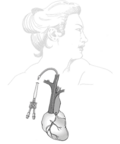Dialysis catheter
Dialysis Catheter
A dialysis catheter is a catheter used for exchanging blood to and from the hemodialysis machine from the patient. This process is essential for patients suffering from advanced chronic kidney disease (CKD) or acute kidney injury (AKI), where the kidneys are no longer able to filter waste products from the blood effectively. Dialysis catheters are a vital component in providing life-sustaining dialysis treatment for these patients.
Types of Dialysis Catheters
There are primarily two types of dialysis catheters: venous and arteriovenous fistula (AVF) catheters. Venous catheters are inserted into a large vein, typically in the neck, chest, or groin. These are often used for short-term access. On the other hand, arteriovenous fistula catheters are created surgically by connecting an artery to a vein, usually in the arm, and are intended for long-term use.
Tunneled Catheters
Tunneled dialysis catheters are placed under the skin to reduce the risk of infection. They have a cuff that promotes tissue growth to help secure the catheter in place and act as a barrier to bacteria.
Non-Tunneled Catheters
Non-tunneled catheters are typically used for emergency or short-term dialysis access. They are inserted directly into a vein without being tunneled under the skin and have a higher risk of infection compared to tunneled catheters.
Complications
The use of dialysis catheters can be associated with several complications. The most common include infection, thrombosis (blood clots), and catheter malfunction. Infections can be serious and lead to hospitalization. Thrombosis can reduce the efficiency of dialysis by blocking the flow of blood. Regular monitoring and care are essential to minimize these risks.
Care and Maintenance
Proper care and maintenance of the dialysis catheter are crucial to prevent complications. This includes regular cleaning of the catheter site, ensuring the catheter is securely in place, and monitoring for signs of infection or other problems. Healthcare providers will provide detailed instructions on catheter care to patients and caregivers.
Conclusion
Dialysis catheters play a critical role in the management of kidney failure, providing a lifeline for patients requiring hemodialysis. While they are associated with certain risks, careful selection, insertion, and maintenance can help minimize complications and ensure effective dialysis treatment.
Transform your life with W8MD's budget GLP-1 injections from $125.
W8MD offers a medical weight loss program to lose weight in Philadelphia. Our physician-supervised medical weight loss provides:
- Most insurances accepted or discounted self-pay rates. We will obtain insurance prior authorizations if needed.
- Generic GLP1 weight loss injections from $125 for the starting dose.
- Also offer prescription weight loss medications including Phentermine, Qsymia, Diethylpropion, Contrave etc.
NYC weight loss doctor appointments
Start your NYC weight loss journey today at our NYC medical weight loss and Philadelphia medical weight loss clinics.
- Call 718-946-5500 to lose weight in NYC or for medical weight loss in Philadelphia 215-676-2334.
- Tags:NYC medical weight loss, Philadelphia lose weight Zepbound NYC, Budget GLP1 weight loss injections, Wegovy Philadelphia, Wegovy NYC, Philadelphia medical weight loss, Brookly weight loss and Wegovy NYC
|
WikiMD's Wellness Encyclopedia |
| Let Food Be Thy Medicine Medicine Thy Food - Hippocrates |
Medical Disclaimer: WikiMD is not a substitute for professional medical advice. The information on WikiMD is provided as an information resource only, may be incorrect, outdated or misleading, and is not to be used or relied on for any diagnostic or treatment purposes. Please consult your health care provider before making any healthcare decisions or for guidance about a specific medical condition. WikiMD expressly disclaims responsibility, and shall have no liability, for any damages, loss, injury, or liability whatsoever suffered as a result of your reliance on the information contained in this site. By visiting this site you agree to the foregoing terms and conditions, which may from time to time be changed or supplemented by WikiMD. If you do not agree to the foregoing terms and conditions, you should not enter or use this site. See full disclaimer.
Credits:Most images are courtesy of Wikimedia commons, and templates, categories Wikipedia, licensed under CC BY SA or similar.
Contributors: Prab R. Tumpati, MD



